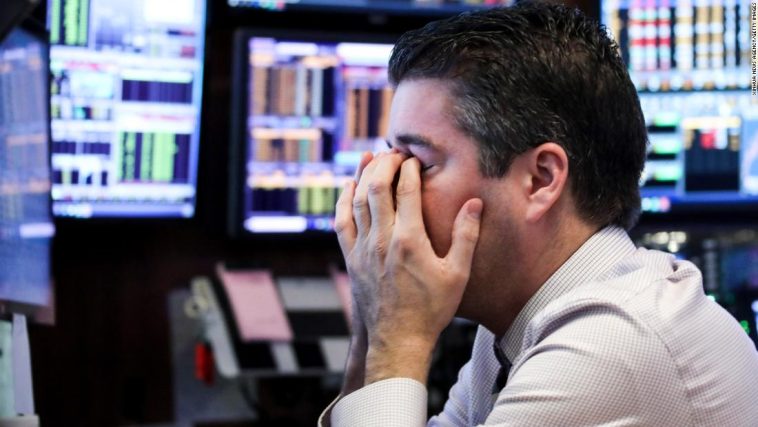[vc_row][vc_column][vc_custom_heading text=”12 Wall Street Biggest Crashes” use_theme_fonts=”yes”][vc_column_text]Wall Street, the bastion of the world’s economic status in New York, has this instantly recognizable massive bronze bull outside it. This symbolizes the potency of the institution and the spirit of the free world’s greatest market.[/vc_column_text][vc_column_text]It naturally also encapsulates everything that a bull market represents – strength, virility and an indomitable reaching forwards to better and greater things. Aside from being a tourist attraction, the statue has been known to be shunned by visitors during downturns.[/vc_column_text][/vc_column][/vc_row][vc_row][vc_column][vc_column_text]
[/vc_column_text][/vc_column][/vc_row][vc_row][vc_column][vc_custom_heading text=”Black Monday” use_theme_fonts=”yes”][vc_column_text]This event of October 1987 is when stock markets worldwide crashed. It was only felt in the US after other markets had been subject to large declines.[/vc_column_text][vc_single_image image=”12491″ img_size=”large” alignment=”center”][vc_column_text el_class=”content-img-src”]Image source: pinterest[/vc_column_text][vc_column_text]The Black Monday (also known as Black Tuesday because of time differences) crash was, and has held the distinction since, of being the largest one-day percentage decline in the DJIA.[/vc_column_text][/vc_column][/vc_row][vc_row][vc_column][vc_column_text]
[/vc_column_text][/vc_column][/vc_row][vc_row][vc_column][vc_custom_heading text=”Dot Com bubble” use_theme_fonts=”yes”][vc_column_text]This was the collapse of a technology bubble on March 10, 2000. The Nasdaq Composite stock market index, which held numerous Internet-based businesses, peaked in value on March 10, 2000, before crashing. This was the end of excessive speculation, mainly in the US, roughly from 1995 to 2000, highlighting extreme growth in the use of the Internet.[/vc_column_text][vc_single_image image=”12492″ img_size=”large” alignment=”center”][vc_column_text el_class=”content-img-src”]Image source: youtube[/vc_column_text][vc_column_text]The bubble was caused by the massive upswing in the number of Internet-based companies, with investors weighing in heavily without cautioning as to whether such companies could turn a profit. It was almost like a mass hysteria movement which, without a solid foundation, had to collapse. Investors were terrified of not being able to cash in on the swing and abandoned all reason to the wind. Lesson learned.[/vc_column_text][/vc_column][/vc_row][vc_row][vc_column][vc_column_text]
[/vc_column_text][/vc_column][/vc_row][vc_row][vc_column][vc_custom_heading text=”Downturn of 2002″ use_theme_fonts=”yes”][vc_column_text]This event was a downturn in stock prices during 2002 and was felt not only on the NYSE but also in Canada, Asia, and Europe. After recovering from the lows reached following the 9/11 attacks, indices started to slide in March 2002 with sharp declines in July and September, reaching lows last seen in 1997 and 1988.[/vc_column_text][vc_single_image image=”12494″ img_size=”large” alignment=”center”][vc_column_text el_class=”content-img-src”]Image source: pinterest[/vc_column_text][vc_column_text]An explosion of accounting scandals – Arthur Anderson, Adelphia, Enron and WorldCom – also contributed to the speed of the downturn as many corporations were forced to restate earnings, some leading to negative outcomes, leading to the loss of investor confidence.[/vc_column_text][/vc_column][/vc_row][vc_row][vc_column][vc_column_text]
[/vc_column_text][/vc_column][/vc_row][vc_row][vc_column][vc_custom_heading text=”US bear market 2007-2009″ use_theme_fonts=”yes”][vc_column_text]This 17-month bear market occurred during the financial crisis of 2007-2009. The S&P 500 lost almost 50% of its value but there were strong interventions by governments and central banks to cushion the NYSE.[/vc_column_text][vc_single_image image=”12495″ img_size=”large” alignment=”center”][vc_column_text el_class=”content-img-src”]Image source: twitter[/vc_column_text][vc_column_text]There was continuing debate as to the cause of the bear market. The Republicans and Democrats were strongly divided, and there emerged three camps – those that blamed the economy, those that blamed the Bush administration and others that wanted to shove the blame onto the arriving newbies, the Obama administration.[/vc_column_text][/vc_column][/vc_row][vc_row][vc_column][vc_column_text]
[/vc_column_text][/vc_column][/vc_row][vc_row][vc_column][vc_custom_heading text=”Financial crisis of 2007-2008″ use_theme_fonts=”yes”][vc_column_text]This was the biggest crisis of recent times and what started off in Wall Street soon spread around the globe. There was hardly a market that was untouched by the crisis. Here’s what happened – failures of big financial institutions in the US, due largely to exposure of securities of packaged subprime loans and credit default swaps issued to insure these loans, quickly evolved into a global crisis. A crisis that led to failures of banks in Europe and steep declines in the value equities and commodities globally.[/vc_column_text][vc_single_image image=”12496″ img_size=”large” alignment=”center”][vc_column_text el_class=”content-img-src”]Image source: twitter[/vc_column_text][vc_column_text]Later, President George Bush signed the Emergency Economic Stabilization Act, building a Troubled Asset Relief Program (TARP) to acquire falling bank assets. All in all, the crisis had disastrous effects on the global economy and trading around the world.[/vc_column_text][/vc_column][/vc_row][vc_row][vc_column][vc_column_text]
[/vc_column_text][/vc_column][/vc_row][vc_row][vc_column][vc_custom_heading text=”2010 Flash Crash” use_theme_fonts=”yes”][vc_column_text]The Dow Jones Industrial Average (DJIA) suffered its worst intra-day point loss, falling almost 1 000 points before it attempted recovery.[/vc_column_text][vc_single_image image=”12497″ img_size=”large” alignment=”center”][vc_column_text el_class=”content-img-src”]Image source: imgur[/vc_column_text][vc_column_text]This was a trillion-dollar stock market crash which lasted 36 minutes. The market rebounded rapidly afterward, but the shockwave had long-lasting effects on trading dynamics. A report later described it as one of the most turbulent periods in the history of financial markets, certainly of the NYSE, but of markets generally the world over. It is interesting to note that flash crashes happen quite regularly, but measures installed after such events usually have little effect on preventing them later.[/vc_column_text][/vc_column][/vc_row][vc_row][vc_column][vc_column_text]
[/vc_column_text][/vc_column][/vc_row][vc_row][vc_column][vc_custom_heading text=”2011 stock markets fall” use_theme_fonts=”yes”][vc_column_text]This was the rapid, steep fall in stock prices which occurred in August 2011 in stock exchanges across the US, Middle East, Europe, and Asia.[/vc_column_text][vc_single_image image=”12498″ img_size=”large” alignment=”center”][vc_column_text el_class=”content-img-src”]Image source: pinterest[/vc_column_text][vc_column_text]It was primarily due to fears of contagion of the European sovereign debt crisis to Spain and Italy, as well as a focus on France’s AAA rating. Standard & Poor’s downgraded America’s credit rating for the first time, and Moody’s also warned of a potential downgrade. Extreme volatility of stock market indexes on the NYSE lasted the rest of the year.[/vc_column_text][/vc_column][/vc_row][vc_row][vc_column][vc_column_text]
[/vc_column_text][/vc_column][/vc_row][vc_row][vc_column][vc_custom_heading text=”2015-16 stock market selloff” use_theme_fonts=”yes”][vc_column_text]The Dow Jones plummeted 588 points over a two-day period, 1 300 points from August 18-21. On August 24, stock markets globally had dropped significantly, erasing all gains made in 2015.[/vc_column_text][vc_single_image image=”12499″ img_size=”large” alignment=”center”][vc_column_text el_class=”content-img-src”]Image source: twitter[/vc_column_text][vc_column_text]Investors got rid of shares worldwide as a result of the growth slowdown in the GDP of China, there was a sharp drop in petroleum prices, the debt default in Greece, the effects of the end of quantitive easing in the US, a sharp rise in bond yields and in June 2016 the UK-EU membership referendum which resulted in a ‘leave’ vote, commonly known as Brexit. By July 2016, the DJIA had recovered and posted record gains.[/vc_column_text][/vc_column][/vc_row]


